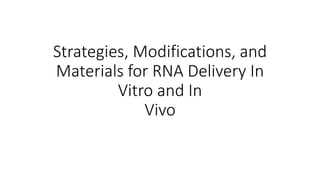
Strategies, Modifications, and Materials for RNA Delivery In Vitro and In Vivo
- 1. Strategies, Modifications, and Materials for RNA Delivery In Vitro and In Vivo
- 2. Cause of many diseases • Cancer - overexpression of specific oncogenes • Type I and type II diabetes - cellular resistance and/or the autoimmune response • Cystic fibrosis - production of proteins of incorrect structure Aberrant protein production
- 3. Traditional Methods Small molecules and protein based drugs Advantages Small-molecule-based drugs can enter target cells and often act by inhibiting specific proteins through competitive binding. Protein therapeutics offer increased specificity for their molecular targets or replace defective and/or missing proteins. Limitations Small molecules can readily accumulate in off-target tissues and are often poorly soluble. It can be difficult to deliver exogenous proteins into the cytoplasm of target cells, and stability as well as size concerns with protein therapeutics can limit their application.
- 4. Alternative Method RNA siRNA, ASO, miRNA can silence specific genes to decrease protein concentrations mRNA can be translated by ribosomes to upregulate protein concentrations within target cells (which, in turn, can also be secreted into the bloodstream) Hybrid RNA can alter DNA at the molecular level to correct defective genes
- 5. Barriers in RNA administration Extracellular When administered systemically, RNAs trigger a similar immune response to that of invading pathogens given their similarity in molecular structure. RNAs are prone to degradation in the bloodstream due to chemical instability as well as the presence of circulating nucleases. Upon exiting the bloodstream, RNAs must then navigate a complex extracellular matrix (ECM) and localize to target cells. Intracellular RNAs must enter into the cytoplasm or nucleus. Large, anionic biomolecules do not readily traverse the cellular membrane and can instead become entrapped within endosomal compartments.
- 6. to transfect target cell populations in vitro with naked, unmodified RNAs. Inefficient because the charge density, size, and hydrophilicity of nucleic acids prevent efficient translocation of RNAs across cellular membranes. electroporation, microinjection, sonoporation, laser irradiation, and hydrostatic pressure transfection. Efficient by altering cell behaviours in vitro by silencing genes and upregulating the concentration of encoded proteins in a dose dependent and time controlled manner.
- 7. Physiological Barriers instability and immunogenicity of naked, unmodified RNAs mechanisms to prevent exogenous RNAs from entering target cells pattern recognition mechanisms, including toll like receptors nonspecific tissue accumulation can limit the targeting of specific organs
- 8. Strategies to overcome barriers to alter RNA sequences with chemically modified sugars and linkers Sugar and linker modification strategies are best suited for short RNAs that can be synthesized via established oligonucleotide synthesis techniques; longer RNAs (such as mRNA) are traditionally produced using in vitro transcription and are, accordingly, more difficult to modify in this fashion.
- 9. • 2′-fluoro • 2′-O-methyl • 2′-deoxy Sugar modifications - involve substituting the endogenous 2′-hydroxy group with • can be used for both short and long RNAs • base pair modifications within siRNAs and ASOs are generally better tolerated than those found in mRNAs. • variations in the untranslated region, 5′ caps, and polyadenylated 3′ tails are more commonly employed in potential mRNA therapeutics. base pair modification strategies • replace endogenous phosphodiester bonds with phosphorothioate or amide-based linkages. Linker modifications
- 10. Direct conjugation strategies improve the pharmacokinetic properties of a given RNA sequence effect on therapeutic targeting of specific organs (due in part to receptor mediated endocytosis) frequently explored for applications involving siRNAs. the sense strand can be readily modified with a targeting ligand without significantly interfering with the silencing potential of the siRNA.
- 11. Strategies to overcome barriers
- 12. Electrostatic Complexation Cationic delivery systems Condense anionic RNA Protecting RNS from degradation Improve circulation time, stability and cellular uptake
- 13. Cationic lipids polar amine cores covalently modified with nonpolar hydrophobic tails permanently cationic centres (quaternary ammonium salts) amine cores that can be reversibly protonated (ionizable amines) In general, ionizable amines demonstrate improved toxicity profiles relative to quaternary ammonium salts.
- 14. LNPs (Lipid nanoparticles) • To improve the potency of lipoplexes, additional excipients can be coformulated alongside the cationic lipid to form lipid nano-particles (LNPs). • LNPs are composite supramolecular materials consisting of four primary components in addition to the nucleic acid.
- 15. four primary components in LNP LNP efficacy and bio-distribution can be tailored in vivo by either modulating the ratio of these four components or by designing and synthesizing new ionizable/cationic lipids. cholesterol (fluidizes the membrane) lipid anchored poly(ethylene glycol) (decreases nonspecific uptake and aggregation) a phospholipid (modifies bilayer structure) an ionizable/cationic lipid (complexes the RNA and improves endosomal escape)
- 16. Nonlipid-based nanoparticles • Nonlipid-based nanoparticles have also been explored as therapeutic delivery options, including those derived from gold. • These particles have demonstrated potency in the brain and can also reverse impaired wound healing. • Interestingly, these gold siRNA nanoparticles can also be administered topically for gene regulation.
- 17. Polymeric materials • chitosan (consists of repeating units of N-acetyl-D-glucosamine and D- glucosamine subunits) • polyaspartamide (consists of repeating units of aspartamide) • poly-L-lysine (consists of repeating units of lysine) Natural and naturally derived polymers • polyethylenimine (a water-soluble polymer that can exist in linear, branched, and dendritic forms) • poly(beta-amino esters) Synthetic materials
- 18. hybridized approaches mitigate immunogenicity increase stability promote cellular uptake improve the potency of the therapeutic
- 19. first drug of its class to successfully reach this endpoint Patisiran, an RNAi-based therapy for the treatment of ATTR amyloidosis with polyneuropathy, successfully passed phase III clinical trials Impact on pharmaceutical market in real time